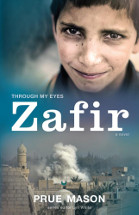Zafir by Prue Mason

Through my eyes series. Allen & Unwin, 2015. ISBN
9781743312544
(Age: 11+) Highly recommended. Syria, Dictatorship. When Zafir and
his family move back to Syria, Zafir has little idea of what life
will be like. He has been brought up in Dubai where he has mixed
with a range of other kids his age from all countries of the world.
He has been allowed to do things he wishes to do: talk openly about
politics, use Facebook and a mobile phone without restriction, see
the people he wants to see and so on, but when his father accepts a
job in the hospital at Homs, his life changes dramatically. Here
there are secrets, secrets he has little idea about, secrets when
shared must be kept under wraps. His uncle seems to have more
liberal views but again no one must know. His mother uses email, but
only through a secret address and she has ideas about freedoms which
too must never be discussed. His one friend at school, Rami also has
secrets, and Zafir thinks it may have something to do with why the
other boys call him names. When he finds out he must make a choice
between his friend and the gang that pursues him. But one day he and
his mother go to Damascus to see his uncle, without telling their
father and here they see a brave few demonstrate against the
government and see their uncle beaten and taken away by the police.
The secrets have come out into the open and Zafir and his family are
caught in the backlash when after a demonstration in Homs, his
father helps a young man who has been shot by the police.
Another in the fine series, Through my eyes, sees Zafir at the
centre of the story, a twelve year old Syrian boy exposed to a
different lifestyle, seeing his own country's dark heart.
Through his eyes we see the terror under which many people live, the
role of the state police and the cruel way some are treated. We see
the more liberal minded striving for freedoms we take for granted in
the West, and what happens to them when they call for change.
A timeline of Syria's history fills in some of the background to the
novel, and can be found at the end of the book, along with a
dictionary of the Arabic words found in the text and information
about the other books in the series. A map at the start of the book
helps readers place where the story is set. This is a most readable
and engaging book about a country we hear little of. It could well
be used as a class set, as with any of this fine series, or a study
where the class selects one of the Through My Eyes series to
read in a group.
Fran Knight